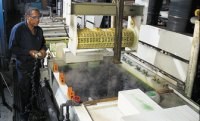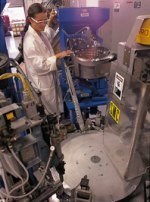Total Integration is Key to Quality Control
Microcast provides the diecasting as well as the electroless nickel plating...
A critical element in controlling quality of plating miniature zinc-diecast parts is minimizing the variability of plating baths. But, that is not the only one. Another is assuring the quality of the castings prior to plating.
Microcast, a subsidiary of Paramount Metal Finishing, Inc., Linden, NJ, recognized early on that grasping more of the entire process was the key to being a successful supplier. Now, the company is a totally integrated manufacturer of these parts, mainstays of the communications connector industry.
"Although plating and finishing was our main business, we saw that the diecasting process itself was key to controlling the quality of the finished product," said Michael Fuschetti, vice president of manufacturing. "So we decided to work in reverse, the finisher became the diecaster as well. We made this commitment almost 10 years ago, and we have never looked back," he added.
Plating on zinc diecast: a growth area
It took Microcast many years to develop a plating process with wide enough operating parameters to accommodate the different types of zinc diecasts (see Table I) and the inconsistencies in the zinc diecastings' quality. Diecastings made from zinc alloys vary in composition, and may have cracks, crevices, blisters, pores and flash at parting lines that make them a challenge to plate uniformly.
Diecast surfaces with fissures caused by "cold shut" or other forms of porosity tend to corrode prematurely, even when satisfactory cleaning and plating procedures are followed. "Porosity," stated Mr. Fuschetti, "is the major problem we face in plating zinc diecastings and is the ultimate factor in whether we produce a component with outstanding corrosion protection or not."
Totally integrated
"Customers come to us with a part that needs to be diecast. We develop a tool for the part, diecast it and machine it if necessary," Mr. Fuschetti explained. "Finally, we plate and assemble it with other components if needed. Then it is shipped as a finished part or component. All of this happens under one roof." This total integration, somewhat singular in the zinc diecasting/finishing business, is what sets Microcast apart. It gives the company total control of the entire process from start to finish.
Depending on the part and its ultimate use, either a medium- or high-phosphorus electroless nickel (EN) plating process is used. Some customers find it more economical to specify medium phosphorus, while others prefer the more corrosion-resistant, non-magnetic properties of a high-phosphorus EN coating. For certain electrical components, a magnetic finish is not desirable.
Typical plating cycle
Microcast has developed a proprietary pretreatment procedure that allows it to plate zinc diecasts with excellent adhesion while at the same time not affecting the surface finish of the zinc diecast. Zinc-alloy diecastings are amphoteric and may be attacked by contact with strongly acidic or alkaline solutions, so overexposure is to be avoided at all stages of the process cycle.
Before Microcast accepts a job, sample parts are processed to determine the amount of zinc material that must be removed and the plating thickness needed to meet final dimensions.
A typical zinc diecast plating cycle involves using a soak cleaner followed by several rinses with either an acid activation or a chemical milling stage. The acid activation is typically fluoride, and the chemical mill is also fluoride based.
When using a chemical milling process, a considerable amount of basis metal is removed. However, using a mild acid as an activator removes less basis metal and does not disturb the surface very much. This is followed by plating 0.0002 to 0.0004 inch of EN over the copper substrate, followed by several rinses and spin-drying.
Medium- and high-phosphorus processes
For high-phosphorus jobs, Microcast uses OMG Fidelity 5005 or 5023 EN. The 5005 product is a self-pH-regulating process that provides highly consistent plating rates and excellent solution stability. Its unique stabilizer and buffering system give an ultra-smooth, non-magnetic nickel coating designed for use with ferrous, non-ferrous and other non-conductive substrates. The plating deposit is compressively stressed for better ductility and offers a stain-resistant finish. For a more decorative bright finish, Microcast uses the supplier's 4880 plating bath.
Tight control over plating chemistry is a must. Microcast's in-house laboratory analyzes solutions daily. The EN baths are continuously monitored and controlled using automatic controllers that maintain the EN chemistry within acceptable tolerances.
The units use a spectrophotometer to monitor and maintain the concentration of nickel within the bath and keep it performing at its optimum. The company works closely with its chemical supplier to head off most zinc diecast plating issues before they become problems. For instance, one problem area is zinc getting into the EN plating bath where it can have a dramatic effect if allowed to build up unchecked. That is when the chemical supplier with an outstanding laboratory can be of great assistance. Also, it can help with plating economies, since some baths are more zinc tolerant than others are.
Microcast's business is quality castings
The bulk of the EN-plated parts go to connector-based products for cable communications and test points for PC boards. The company stresses the importance of several elements in successful plating of zinc diecast parts. The cast parts should be dense with little surface porosity. Microcast prides itself on using only virgin alloy, and because no recycled or remelted material is used, it is essentially pure material. "We try to use a minimum amount of special lubricants for cleaning ease in the diecast process, and this also ensures that there will be nothing to prevent good adhesion of the surface coating to the cast part," Mr. Fuschetti pointed out.
"Our business is growing all of the time," Mr. Fuschetti added. "Currently we operate with about 80,000 sq ft of plant space. We recently added 20,000 sq ft just to handle our zinc-diecasting operation. Therefore, we can diecast about 100,000 components daily and plate them with a variety of finishes.
"To successfully compete in the highly demanding market of EN plating or zinc diecastings, you have to start with quality castings. The way we have found to be the best way to address the problem was to be our own diecasting supplier. The other part is to team up with a reliable and quality chemical supplier, one with a broad range of in-plant and laboratory support services. The combination has proved a win-win situation for both Microcast and the supplier," Mr. Fuschetti concluded.
| TABLE I—Common Zinc Alloys | |||||
| Composition Percentage By Weight |
ASTM Designation General Designation |
Zinc AG40A Zamak 3 |
Zinc AG41A Zamak 5 |
Zinc-Aluminum ZA-8 (Diecast) ZA-8 |
|
| AI Cu Mg Fe Pb Cd Sn Zn |
Aluminum Copper Magnesium Iron Lead Cadmium Tin Zinc (99.99%) |
3.5-4.3 0.25 Max. 0.025-0.05 0.100 Max. 0.005 Max. 0.004 Max. 0.003 Max. Remainder |
3.5-4.3 0.75-1.25 0.03-0.08 0.100 Max. 0.005 Max. 0.004 Max. 0.003 Max. Remainder |
8.0-8.8 0.8-1.3 0.015-0.030 0.075 Max. 0.006 Max. 0.006 Max. 0.003 Max. Remainder |
|
To learn more visit OMG Electronic Chemicals, LLC.
Read Next
A ‘Clean’ Agenda Offers Unique Presentations in Chicago
The 2024 Parts Cleaning Conference, co-located with the International Manufacturing Technology Show, includes presentations by several speakers who are new to the conference and topics that have not been covered in past editions of this event.
Read MoreEducation Bringing Cleaning to Machining
Debuting new speakers and cleaning technology content during this half-day workshop co-located with IMTS 2024.
Read MoreEpisode 45: An Interview with Chandler Mancuso, MacDermid Envio Solutions
Chandler Mancuso, technical director with MacDermid Envio discusses updating your wastewater treatment system and implementing materials recycling solutions to increase efficiencies, control costs and reduce environmental impact.
Read More











.jpg;maxWidth=300;quality=90)










